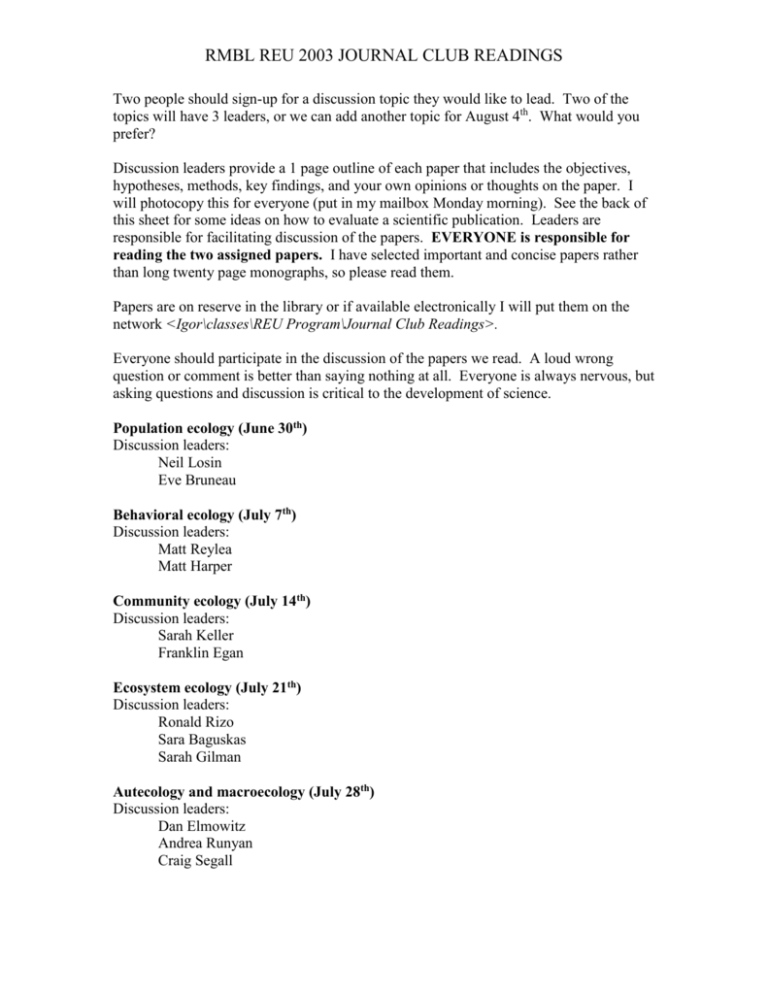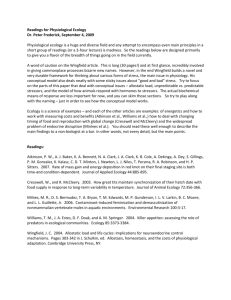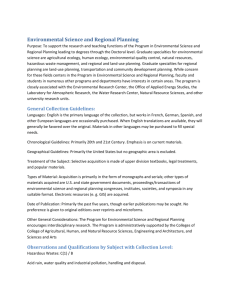Population biology
advertisement

RMBL REU 2003 JOURNAL CLUB READINGS Two people should sign-up for a discussion topic they would like to lead. Two of the topics will have 3 leaders, or we can add another topic for August 4th. What would you prefer? Discussion leaders provide a 1 page outline of each paper that includes the objectives, hypotheses, methods, key findings, and your own opinions or thoughts on the paper. I will photocopy this for everyone (put in my mailbox Monday morning). See the back of this sheet for some ideas on how to evaluate a scientific publication. Leaders are responsible for facilitating discussion of the papers. EVERYONE is responsible for reading the two assigned papers. I have selected important and concise papers rather than long twenty page monographs, so please read them. Papers are on reserve in the library or if available electronically I will put them on the network <Igor\classes\REU Program\Journal Club Readings>. Everyone should participate in the discussion of the papers we read. A loud wrong question or comment is better than saying nothing at all. Everyone is always nervous, but asking questions and discussion is critical to the development of science. Population ecology (June 30th) Discussion leaders: Neil Losin Eve Bruneau Behavioral ecology (July 7th) Discussion leaders: Matt Reylea Matt Harper Community ecology (July 14th) Discussion leaders: Sarah Keller Franklin Egan Ecosystem ecology (July 21th) Discussion leaders: Ronald Rizo Sara Baguskas Sarah Gilman Autecology and macroecology (July 28th) Discussion leaders: Dan Elmowitz Andrea Runyan Craig Segall RMBL REU 2003 JOURNAL CLUB READINGS Discussion leaders please put a check next to the 2 papers and return to my mailbox by Wednesday. Papers are on reserve in the library or if available electronically I will put them on the network <Igor\classes\REU Program\Journal Club Readings>. Population ecology (June 30th) ______ May, R.M. 1974. Biological populations with non-overlapping generations: stable points, stable cycles, and chaos. Science 186: 645-647. ___X___ Hutchison, G.E. 1959. Homage to Santa Rosalia; or, why are there so many kinds of animals? American Naturalist 93:145-159. ______ Holling, C.S. The components of predation as revealed by a study of small mammal predation of the European pine sawfly. Canadian Entomologist 91: 293320 ______ Coley, P.D. J.P. Bryant, and F.S. Chapin III. 1985. Resource availability and plant antiherbivore defense. Science 230: 895-899. ______ Turchin, P. 2001. Does population ecology have general laws? Oikos 94: 17-26. ___X___ Post, E. and M.C. Forchammer. 2003. Synchronization of animal population dynamics by large-scale climate. Nature 420: 168-170. RMBL REU 2003 JOURNAL CLUB READINGS Discussion leaders please put a check next to the 2 papers and return to my mailbox by Wednesday. Papers are on reserve in the library or if available electronically I will put them on the network <Igor\classes\REU Program\Journal Club Readings>. Behavioral ecology (July 7th) __X____ Ben-David, M., R. T. Bowyer, L. K. Duffy, D. D. Roby and D. M. Schell 1998. Social behavior and ecosystem processes: river otter latrines and nutrient dynamics of terrestrial vegetation. Ecology 79: 2567-2571. ______ Charnov, E.L. 1976. Optimal foraging, the marginal value theorem. Theoretical population biology. 9: 129-136. ______ MacArthur, R. H. and E. R. Pianka 1966. On optimal use of a patchy environment. American Naturalist 100: 603-609. ______ Peckarsky, B. L., A. R. McIntosh, B. W. Taylor and J. Dahl 2002. Predator chemicals induce changes in mayfly life history traits: A whole-stream manipulation. Ecology 83: 612-618. ___X___ Temeles, E. J. and W. J. Kress 2003. Adaptation in a plant-hummingbird association. Science 300: 630-633. ______ Waser, N. M. and M. V. Price 1983. Pollinator behaviour and natural selection for flower colour in Delphinium nelsonii. Nature 302: 422-423. RMBL REU 2003 JOURNAL CLUB READINGS Discussion leaders please put a check mark next to 1 older and 1 more recent paper and return to my mailbox by next Monday. Papers are on reserve in the library or if available electronically I will put them on the network <Igor\classes\REU Program\Journal Club Readings>. Community ecology (lots of choices!) ___X___ Hairston, N. G., F. E. Smith and L. B. Slobodkin 1960. Community structure, population control, and competition. American Naturalist 94: 421-425. ______ Paine, R. T. (1966). Food web complexity and species diversity. American Naturalist 100: 482-492. ______ Brooks, J. L. and S. I. Dodson 1965. Predation, body size, and composition of plankton. Science 150: 28-35. ______ Meyer, J. L., E. T. Schultz and G. S. Helfman (1983). Fish schools: An asset to corals. Science 220: 1047-1049. ______ Power, M. E., W. J. Matthews and A. J. Stewart 1985. Grazing minnows, piscivorous bass, and stream algae: dynamics of a strong interaction. Ecology 66: 1448-1456. ______ Strong, D. R. (1992). Are trophic cascades all wet? differentiation and donorcontrol in speciose ecosystems. Ecology 73(3): 747-754. ______ Martinez del Rio, C., A. Silva, R. Medel, and M. Hourdequin (1996). Seed dispersers as disease vectors: bird transmission of mistletoe seeds to plant hosts. Ecology 77(3): 912-921. ______ Knapp, A. K., J. M. Blair, J. M. Briggs, S. L. Collins, D. C. Hartnett, L. C. Johnson and E. G. Towne (1999). The keystone role of bison in North American tallgrass praire. Bioscience 49: 39-50. ______ Wootton, J. T. (1997). Estimates and tests of per capita interaction strength: diet, abundance, and impact of intertidally foraging birds. Ecological Monographs 67(1): 45-64. ______ Polis, G. A. and S. D. Hurd (1996). Linking marine and terrestrial food webs: allochthonous input from the ocean supports high secondary productivity on small islands and coastal land communities. American Naturalist 147(3): 396-423. __X____ Sanders, N. J., N. J. Gotelli, N. E. Heller and D. M. Gordon (2003). Community disassembly by an invasive species. Proceedings of the National Academy of Sciences 100(5): 2474-2477. RMBL REU 2003 JOURNAL CLUB READINGS Discussion leaders please put a check mark next to 1 older and 1 more recent paper and return to my mailbox by Friday. Papers are on reserve in the library or if available electronically I will put them on the network <Igor\classes\REU Program\Journal Club Readings>. Ecosystem ecology ______ Lindeman, R. L. (1942). The trophic-dynamic aspect of ecology. Ecology 23: 399-418. __X____ Odum, E. P. (1969). The strategy of ecosystem development. Science 164: 262270. ______ Tansley, A. G. (1935). The use and abuse of vegetational concepts and terms. Ecology 16: 284-307. ______ Odum, H. T., and Pinkerton, R. C. .1955. Time's speed regulator: the optimum efficiency for maximum power output in physical and biological systems. American. Scientist 43: 331–343. ______ Likens, G. E., Borman, F. H., Johnson, N. M., Fisher, D. W., and Pierce, R. S. 1970. Effects of forest cutting and herbicide treatment on nutrient budgets in the Hubbard Brook watershed-ecosystem. Ecol. Monographs 20: 23–47. ______ Reiners, W. A. (1986). Complementary models for ecosystems. American Naturalist 127: 59-73. ______ Vitousek, P.R. and L.R. Walker. 1989. Biological invasion by Myrica faya in Hawai’i: plant demography, nitrogen fixation, ecosystem effects. Ecology 59: 247-255. ______ Elser, J. J., R. W. Sterner, E. Gorokhova, W. F. Fagan, T. A. Markow, J. B. Cotner, J. F. Harrison, S. E. Hobbie, G. M. Odell and L. J. Weider 2000. Biological stoichiometry from genes to ecosystems. Ecology Letters 3: 540-550. ______ Frank, D. A., M. M. Kuns and D. R. Guido 2002. Consumer control of grassland plant production. Ecology 83: 602-606. ___X___ Carpenter, S. R., J. F. Kitchell, J. R. Hodgson, P. A. Cochran, J. J. Elser, M. M. Elser, D. M. Lodge, D. Kretchmer, X. He and C. N. von Ende 1989. Regulation of lake primary productivity by food web structure. Ecology 68: 1863-1876. RMBL REU 2003 JOURNAL CLUB READINGS Discussion leaders please put a check mark next to 1 older and 1 more recent paper and return to my mailbox by Friday. Papers are on reserve in the library or if available electronically I will put them on the network <Igor\classes\REU Program\Journal Club Readings>. Autecology and macroecology ___X___ Simberloff, D.S. and E.O. Wilson 1969. Experimental zoogeography of islands: the colonization of empty islands. Ecology 50: 278-296. ______ Diamond, J.M. 1973. Distributional ecology of New Guinea birds. Science 179: 759-769. ______ Odum, H. T., and Pinkerton, R. C. .1955. Time's speed regulator: the optimum efficiency for maximum power output in physical and biological systems. American. Scientist 43: 331–343. ______ Fischer, A.G. 1960. Latitudinal gradients in organic diversity. Evolution 14: 6481. ______ Janzen, D.H. 1967. Why mountain passes are higher in the tropics. American Naturalist 101: 230-243. ______ Preston, F.W. 1958. Analysis of the Audubon Christmas bird counts in terms of the lognormal curve. Ecology 39:620-624. ______ Vermeij, G.J. 1991. When biotas meet: understanding biotic interchange. Science 253: 1099-1104. ______ Brown, J.H. and Maurer, B.A. 1986. Evolution of body size: consequences of an energetic definition of fitness. American Naturalist 142: 573:584. ______ Vitousek, P.M. 1994. Beyond global warming: ecology and global change. Ecology 75: 1861-1876. ___X___ Allen, A.P., J.H. Brown, and J.F. Gillooly. 2002. Global biodiversity, biochemical kinetics, and the energetic-equivalence rule. Science 297:1545-1548. ______Rahel, F.J. 2002. Homogenization of freshwater fish faunas across the United States. Science 288: 854-856. _X_____ Gregg, J.W., C.G. Jones, and T.E. Dawson. 2003. Urbanization effects on tree growth in the vicinity of New York City. Nature 424:183-186.







